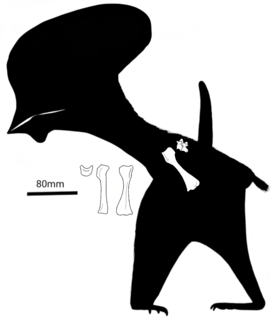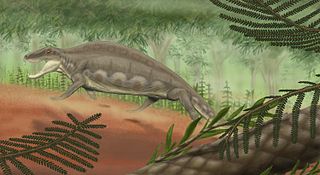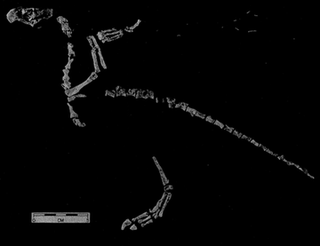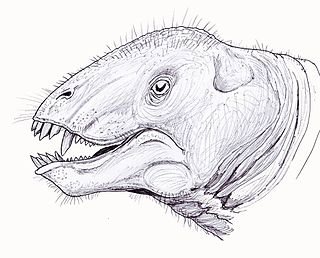 W
WAlvarezsaurus is a genus of small alvarezsaurid dinosaur from the Late Cretaceous, living in Argentina approximately 86 – 83 million years ago. Estimates suggest that it measured about 1.4 meters (4.6 ft) in length and weighed approximately 2.27-9.1 kg (5-20 lbs). In 2010, Gregory S. Paul estimated its weight at 3 kg and length at 1 m. It was found in the Bajo de la Carpa Formation and was named by paleontologist José Bonaparte in 1991 after the historian Don Gregorio Alvarez. The type species is A. calvoi.
 W
WAmargasaurus is a genus of sauropod dinosaur from the Early Cretaceous epoch of what is now Argentina. The only known skeleton was discovered in 1984 and is virtually complete, including a fragmentary skull, making Amargasaurus one of the best-known sauropods of its epoch. Amargasaurus was first described in 1991 and contains a single known species, Amargasaurus cazaui. It was a large animal, but small for a sauropod, reaching 9 to 10 meters in length. Most distinctively, it sported two parallel rows of tall spines down its neck and back, taller than in any other known sauropod. In life, these spines most likely could have stuck out of the body as solitary structures that supported a keratinous sheath. An alternate hypothesis, now less favored, postulates that they could have formed a scaffold supporting a skin sail. They might have been used for display, combat, or defense.
 W
WAmurosaurus is a genus of lambeosaurine hadrosaurid dinosaur found in the latest Cretaceous period of eastern Asia. Like most lambeosaurs, it would have been a primarily bipedal herbivore with a "duckbill" shaped snout and a hollow crest on top of its head, although such a crest has not been found. Fossil bones of adults are rare, but an adult would most likely have been at least 6 metres (20 ft) long. According to Gregory S. Paul, it was about 8 metres (26 ft) long and weighed about 3,000 kilograms (6,600 lb).
 W
WBennettazhia is a genus of tapejaromorph pterosaur from the Early Cretaceous period of what is now the Hudspeth Formation of the state of Oregon in the United States. Although originally identified as a species of the pteranodontoid pterosaur Pteranodon, Bennettazhia is now thought to have been a different animal. The type and only species is B. oregonensis.
 W
WBustylus is an extinct genus of eutherians in the family Adapisoriculidae. It was described by Emmanuel Gheerbrandt and Russell in 1991, and the type species is B. cernaysi, described from the late Paleocene of Cernay, France, and possibly also from Germany. Gheerbrandt later redescribed the species Peradectes marandati as a species of Bustylus. A third species, B. folieae, was described from the early Paleocene of Belgium by Eric De Bast, Bernard Sigé and Thierry Smith in 2012. B. folieae was named in honour of Dr. Annelise Folie.
 W
WComahuesuchus is an extinct genus of notosuchian crocodylomorphs from the Santonian Bajo de la Carpa Formation of Argentina. It was described by palaeontologist José Bonaparte in 1991. The type species is C. brachybuccalis.
 W
WCtenorhachis is an extinct genus of the family Sphenacodontidae. Ctenorhachis was related to Dimetrodon, but did not belong to the same subfamily as Dimetrodon and Sphenacodon, being a more basal member of Sphenacodontidae. Ctenorhachis lived in the Early Permian epoch. Two specimens are known that have been found from the Wichita Group outcropping in Baylor and Archer counties, north-central Texas. Only the vertebrae and pelvis are known. Articulated vertebrae from the holotype specimen possess blade like neural spines that are greatly enlarged, although not nearly to the extent that can be seen in more derived sphenacodontds such as Dimetrodon and Secodontosaurus, in which they form a large sail. The pelvis is nearly identical to that of Dimetrodon. As suggested in the original description of the genus, Ctenorhachis may represent a short-spined sexual dimorph, although the authors find this unlikely.
 W
WEuronychodon is the name given to a genus of coelurosaur dinosaur from the Late Cretaceous of Europe and Asia. Euronychodon is known from teeth only. These are similar to those of another coelurosaur tooth genus, Paronychodon.
 W
WHenkelotherium is an extinct genus of mammal from the Late Jurassic (Kimmeridgian) Camadas de Guimarota, in Portugal. It differs from most other paurodontids in having more postcanine teeth.
 W
WIgdamanosaurus, meaning "lizard from Igdaman", is an extinct genus of Cretaceous marine lizard belonging to the mosasaur family. It is classified as part of the Globidensini tribe, and is like the other members of the tribe recognised by its rounded and knob-like teeth. These teeth indicate a highly specialized lifestyle, likely including a durophagous diet.
 W
WIgua is an extinct genus of iguanian lizards belonging to a group called Gobiguania that was endemic to the Gobi Desert during the Late Cretaceous. The type species Igua minuta was named in 1991 on the basis of a skull from the Barun Goyot Formation in Mongolia. The skull itself is very small, only 14 millimetres (0.55 in) long, and may have belonged to a juvenile given that it possesses a large fontanelle and that many of the bones are unfused. The snout-vent length of the individual is estimated to have been 55 to 65 millimetres. Igua differs from related gobiguanians like Polrussia in having a more rounded skull. It is similar in appearance to the living genera Liolaemus and Tropidurus. The teeth are tricuspid and pleurodont, meaning they are attached to inner surfaces of the jaws.
 W
WJanenschia is a large herbivorous sauropod dinosaur from the Late Jurassic Tendaguru Formation of Tanzania, Africa, 155 million years ago.
 W
WKainops is a genus of trilobites from the family Phacopidae, order Phacopida. It can be distinguished from Paciphacops by the greater number of facets to the eye. The form of the furrow between the palpebral area and the palpebral lobe also distinguishes Kainops from the genera Paciphacops and Viaphacops.
 W
WKonzhukovia is an amphibian genus that belongs to an extinct group of temnospondyls, the largest clade of basal tetrapods including about 198 genera, 292 species, and more than half of which were alive during the early Mesozoic period. The animal was a predator that lived about 260 million years ago, and could get up to about 3 meters in length. Specifically, Konzukovia lived during the Permian, between 252 and 270 million years ago according to the type of rock the fossil was found in. There are three species within this genus, K. vetusta, K. tarda, and K. sangabrielensis, the first two originating from Russia while the latest originating from Southern Brazil. The discovery of this specimen in Southern Brazil provided more evidence to support the idea that during this animals existence, there was a “biological corridor” because of the supercontinent Pangea, allowing these species to be found so far apart from each other. Konzhukovia belongs to the family Archegosauridae, a family consisted of large temnospondyls that most likely compare to modern day crocodiles. Since the discovery of the latest species, K. sangabrielensis Pacheco proposes that there must be the creation of a new family, Konzhokoviidae, a monophyletic group in a sister-group relationship with Stereospondlyi in order to accommodate the three species. Konzhukovia skulls usually exhibit typical rhinesuchid features including an overall parabolic shape, small orbits located more posteriorly, and the pterygoids do not reach the vomer. These animals were long-snouted amphibians that had clear adaptations made for fish catching, as well as exemplifying aquatic features.
 W
WNeeyambaspis enigmatica is the lesser known of the two species of pituriaspid agnathans. The species lived in estuaries during the Middle Devonian, in what is now the Georgina Basin of Western Queensland, Australia.
 W
WThe Oʻahu moa-nalo is one of two species of moa-nalo in the genus Thambetochen. Moa-nalo are a group of extinct, flightless, large goose-like ducks, which evolved in the Hawaiian Islands of the North Pacific Ocean.
 W
WOligolactoria bubiki is an extinct prehistoric boxfish that lived during the Rupelian epoch from the Middle Oligocene of Moravia, Czech Republic.
 W
WParalouatta is a platyrrhine genus that currently contains two extinct species of small primates that lived on the island of Cuba.
 W
WPituriaspis doylei (Doyle's pituri shield) was one of two known species of jawless fish belonging to the Class Pituriaspida, and is the better known of the two. The species lived in estuaries during the Givetian epoch of the Middle Devonian, 390 million years ago in what is now the Georgina Basin of Western Queensland, Australia.
 W
WProtoavis is a problematic dinosaurian taxon known from fragmentary remains from Late Triassic Norian stage deposits near Post, Texas. Much controversy remains over the animal, and there are many different interpretations of what Protoavis actually is. When it was first described, the fossils were described as being from a primitive bird which, if the identification is valid, would push back avian origins some 60-75 million years.
 W
WSerratolamna is an extinct genus of mackerel sharks belonging to the family Cretoxyrhinidae.
 W
WSinoburius is an extinct genus of Xandarellid artiopodan known from the Cambrian aged Chengjiang Biota of China. It is only known from the type species S. lunaris, which was described in 1991. It is a rare fossil within the Chengjiang assemblage. Like other Xandarellids, Sinoburius has an unmineralised exoskeleton. Adult individuals are around 7-8 millimetres in length, with stalked eyes present on the ventral side.
 W
WThe small-billed moa-nalo, also known as the stumbling moa-nalo, is a species of moa-nalo, one of a group of extinct, flightless, large goose-like ducks, which evolved in the Hawaiian Islands of the North Pacific Ocean. It was described in 1991 from subfossil material collected in September 1982 by Storrs Olson, Helen James and others, from the Auwahi Cave on the southern slopes of Haleakalā, on the island of Maui.
 W
WTapinocaninus is an extinct genus of therapsids in the family Tapinocephalidae, in which it is the most basal member. Only one species is known, Tapinocaninus pamelae .Living during the Middle Permian.
 W
WTarascosaurus is a genus of abelisaurid, theropod dinosaur from Late Cretaceous of France.
 W
WTochisaurus is a genus of small troodontid theropod dinosaur from the Late Cretaceous Period of Mongolia. The type species is Tochisaurus nemegtensis.
 W
WThe turtle-jawed moa-nalo, also formerly referred to as the large Kauai goose, is a species of moa-nalo, one of a group of extinct, flightless, large goose-like ducks, which evolved in the Hawaiian Islands of the North Pacific Ocean. It was described in 1991 from subfossil material collected in 1976 by Storrs Olson from the calcareous Makawehi dunes on the south-eastern coast of the island of Kauai. Its remains have also been found at the nearby Makauwahi Cave site.
 W
WValdoraptor is a genus of theropod dinosaur from the Early Cretaceous. Its fossils were found in England. It is known only from bones of the feet. The holotype, BMNH R2559, was found near Cuckfield in layers of the Tunbridge Wells Sand Formation dating from the late Valanginian. The specimen is damaged lacking parts of the upper and lower ends. It has a conserved length of 215 millimetres (8.5 in) and an estimated length of 240 millimetres (9.4 in). This genus is paleontologically significant for being the first ornithomimosaur specimen known from England and represents the earliest record of ornithomimosaurs.
 W
WVelocisaurus is a genus of ceratosaurian theropod dinosaur from the Late Cretaceous period of Argentina.
 W
WXandarella is an extinct genus of Xandarellid artiopodan known from the Cambrian of China and Morocco, the type species was described in 1991 from the Chengjiang Biota in China. An additional species Xandarella mauretanica was described from the Cambrian Stage 5 Tatelt Formation in Morocco in 2017, which only preseved the ventral anatomy. Like other Xandarellids, the exoskeleton is unmineralised. The cephalon has pronounced eye slits, presumably derived from ancestral ventral stalked eyes.